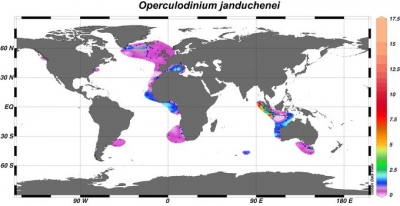Die Inhalte dieser Seite sind leider nicht auf Deutsch verfügbar.
Seitenpfad:
- Modern Dinocyst Key
- transparent cysts
- randomly distributed processes
- transparant cysts hollow processes
- Operculodinium janduchenei
Operculodinium janduchenei
Zonneveld, K.A.F. and Pospelova V. (2015). A determination key for modern dinoflagellate cysts. Palynology 39 (3), 387- 407.
Field characteristics
Operculodinium janduchenei Head et al. 1989
Field characteristics:
Proximochorate subspherical or broadly ellipsoidal cyst with a granulate wall surface. Processes are short conical and hollow, distally closed and apparently nontabular distributed. Archeopyle is precingular with the loss of the 3th paraplate (type P).
Dimensions: Cyst body diameter: 27 to 38 µm; length of processes: 4 µm.
Motile affinity: Unknown.
Stratigraphic range: Middle Miocene to Recent.
Comparison to other species:
O. janduchenei most closely resembles cysts of Operculodinium centrocarpum reduced processes and Operculodinium israelianum with short processes. In contrast to O. centrocarpum, the distal ends of the processes are closed. The process bases are very smooth and no striae are present in contrast to O. israelianum with reduced processes.
Field characteristics:
Proximochorate subspherical or broadly ellipsoidal cyst with a granulate wall surface. Processes are short conical and hollow, distally closed and apparently nontabular distributed. Archeopyle is precingular with the loss of the 3th paraplate (type P).
Dimensions: Cyst body diameter: 27 to 38 µm; length of processes: 4 µm.
Motile affinity: Unknown.
Stratigraphic range: Middle Miocene to Recent.
Comparison to other species:
O. janduchenei most closely resembles cysts of Operculodinium centrocarpum reduced processes and Operculodinium israelianum with short processes. In contrast to O. centrocarpum, the distal ends of the processes are closed. The process bases are very smooth and no striae are present in contrast to O. israelianum with reduced processes.
Geographic distribution
Geographic distribution based on :
Zonneveld et al., 2013. Atlas of modern dinoflagellate cyst distribution based on 2405 datapoints. Review of Palaeobotany and Palynology, v. 191, 1-197
Zonneveld et al., 2013. Atlas of modern dinoflagellate cyst distribution based on 2405 datapoints. Review of Palaeobotany and Palynology, v. 191, 1-197
Operculodinium janduchenei can be regarded as a temperate to equatorial species that occurs where salinity is reduced throughout the year as well as in full-marine environments. It can be found in oligotrophic to eutrophic environments. Its distribution is restricted to regions where hypoxic to well-ventilated bottom waters prevail.

Distribution:
Operculodinium janduchenei is restricted to temperate to equatorial regions. With exception of the temperate North Atlantic and Antarctic Ocean (Indian Sector) where it is found in the central part of the oceans, its distribution restricted to the continental margins. Highest abundances (up to 14.3%) occur in the eastern Indian Ocean off Indonesia.
Environmental parameters:
SST: -1.7 - 27.9°C (winter - summer) with summer SST > 2.5°C. SSS: 17.5 - 38.3 (summer - winter), [P]: 0.06 - 1.24 μmol/l, [N]: 0.2 - 16.27 μmol/l, chlorophyll-a: 0.08 - 18.8 ml/l, bottom water [O2]: between 0.19 - 6.8 ml/l.
O. janduchenei characteristically occurs in regions where salinity is reduced throughout the year by river discharge but it is not restricted to these areas and can occur in high relative abundances in full-marine environments as well. O. janduchenei can be found in oligotrophic to eutrophic environments but is absent in regions where anoxic bottom waters prevail. Highest relative abundances can be observed in regions where bottom waters are well ventilated.
Comparison with other records:
It is not registered from regions other than covered by this Atlas.
Operculodinium janduchenei is restricted to temperate to equatorial regions. With exception of the temperate North Atlantic and Antarctic Ocean (Indian Sector) where it is found in the central part of the oceans, its distribution restricted to the continental margins. Highest abundances (up to 14.3%) occur in the eastern Indian Ocean off Indonesia.
Environmental parameters:
SST: -1.7 - 27.9°C (winter - summer) with summer SST > 2.5°C. SSS: 17.5 - 38.3 (summer - winter), [P]: 0.06 - 1.24 μmol/l, [N]: 0.2 - 16.27 μmol/l, chlorophyll-a: 0.08 - 18.8 ml/l, bottom water [O2]: between 0.19 - 6.8 ml/l.
O. janduchenei characteristically occurs in regions where salinity is reduced throughout the year by river discharge but it is not restricted to these areas and can occur in high relative abundances in full-marine environments as well. O. janduchenei can be found in oligotrophic to eutrophic environments but is absent in regions where anoxic bottom waters prevail. Highest relative abundances can be observed in regions where bottom waters are well ventilated.
Comparison with other records:
It is not registered from regions other than covered by this Atlas.


